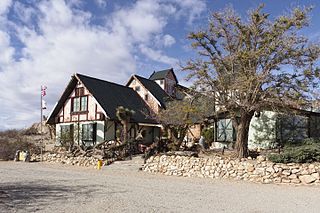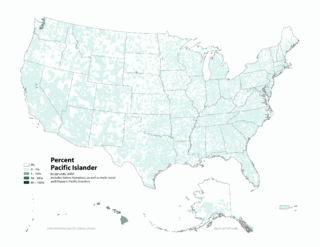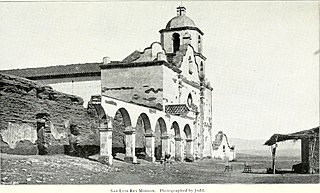
California is a state in the Western United States, lying on the American Pacific Coast. It borders Oregon to the north, Nevada and Arizona to the east, and an international border with the Mexican state of Baja California to the south. With nearly 39 million residents across an area of 163,696 square miles (423,970 km2), it is the most populous U.S. state, the third-largest by area, and most populated subnational entity in North America.

Native Americans, sometimes called American Indians, First Americans, or Indigenous Americans, are the Indigenous peoples of the land that the United States of America is located on. At its core, it includes peoples indigenous to the lower 48 states plus Alaska; it may additionally include any Americans whose origins lie in any of the Indigenous peoples of North or South America. The United States Census Bureau publishes data about "American Indians and Alaska Natives", which it defines as anyone "having origins in any of the original peoples of North and South America and who maintains tribal affiliation or community attachment." The census does not, however, enumerate "Native Americans" as such, noting that the latter term can encompass a broader set of groups, e.g. Native Hawaiians and other Pacific Islander Americans, which it tabulates separately.

Sutter's Fort was a 19th-century agricultural and trade colony in the Mexican Alta California province. Established in 1839, the site of the fort was originally part of a utopian colonial project called New Helvetia by its builder John Sutter, though construction of the fort proper would not begin until 1841. The fort was the first non-Indigenous community in the California Central Valley, and saw grave mistreatment of Indigenous laborers in plantation or feudal style conditions. The fort is famous for its association with the Donner Party, the California Gold Rush, and the formation of the city of Sacramento, surrounding the fort. It is notable for its proximity to the end of the California and Siskiyou Trails, which it served as a waystation.

The California gold rush (1848–1855) was a gold rush that began on January 24, 1848, when gold was found by James W. Marshall at Sutter's Mill in Coloma, California. The news of gold brought approximately 300,000 people to California from the rest of the United States and abroad. The sudden influx of gold into the money supply reinvigorated the American economy; the sudden population increase allowed California to go rapidly to statehood in the Compromise of 1850. The gold rush had severe effects on Native Californians and accelerated the Native American population's decline from disease, starvation, and the California genocide.

The Spanish missions in California formed a series of 21 religious outposts or missions established between 1769 and 1833 in what is now the U.S. state of California. The missions were established by Catholic priests of the Franciscan order to evangelize indigenous peoples backed by the military force of the Spanish Empire. The missions were part of the expansion and settlement of New Spain through the formation of Alta California, expanding the empire into the most northern and western parts of Spanish North America. Civilian settlers and soldiers accompanied missionaries and formed settlements like the Pueblo de Los Ángeles.

Mission Santa Clara de Asís is a Spanish mission in the city of Santa Clara, California. The mission, which was the eighth in California, was founded on January 12, 1777, by the Franciscans. Named for Saint Clare of Assisi, who founded the order of the Poor Clares and was an early companion of St. Francis of Assisi, this was the first California mission to be named in honor of a woman.

Tuolumne County, officially the County of Tuolumne, is a county located in the U.S. state of California. As of the 2020 census, the population was 55,620. The county seat and only incorporated city is Sonora.

Yuba County is a county located in north-central Central Valley, California, United States. As of the 2020 U.S. Census, its population was 81,575. Yuba County is included in the Yuba City metropolitan statistical area, which is also included in the Sacramento–Roseville combined statistical area. The county is in the Central Valley region along the Feather River; the county seat is Marysville.
Cypress is a common name for various coniferous trees or shrubs from the Cupressus genus of the Cupressaceae family, typically found in warm-temperate and subtropical regions of Asia, Europe, and North America.

The Antelope Valley Indian Museum State Historic Park is a state historic park of California, United States, interpreting Native American cultures of the Great Basin and surrounding regions. The park and its grounds are situated on the Antelope Valley's rural east side in northern Los Angeles County, California.

The Patwin are a band of Wintun people in Northern California. The Patwin comprise the southern branch of the Wintun group, native inhabitants of California since approximately 500.

Pacific Islander Americans are Americans who are of Pacific Islander ancestry. For its purposes, the United States census also counts Aboriginal Australians as part of this group.

Mission Indians are the Indigenous peoples of California who lived in Southern california and were forcibly relocated from their traditional dwellings, villages, and homelands to live and work at 15 Franciscan missions in Southern California and the Asistencias and Estancias established between 1769 and 1823 in the Las Californias Province of the Viceroyalty of New Spain.
William Oliver Bright was an American linguist and toponymist who specialized in Native American and South Asian languages and descriptive linguistics.

The history of slavery in California began with the enslavement of Indigenous Californians under Spanish colonial rule. The arrival of the Spanish colonists introduced chattel slavery and involuntary servitude to the area. Over 90,000 Indigenous peoples were forced to stay at the Spanish missions in California between 1770 and 1834, being kept in well-guarded mission compounds. This has been described as de facto slavery, as they were forced to work on the mission's grounds amid abuse, malnourishment, overworking, and a high death rate. Indigenous girls were taken from their parents to be housed in guarded dormitories known as monjeríos for conversion to Catholicism and control over their sexuality.
Lukaiasta is a former Kalindaruk settlement in Monterey County, California.
Tiubta is a former Kalindaruk (Costanoan) settlement in Monterey County, California.

Indigenous peoples of California, commonly known as Indigenous Californians or Native Californians, are a diverse group of nations and peoples that are indigenous to the geographic area within the current boundaries of California before and after European colonization. There are currently 109 federally recognized tribes in the state and over forty self-identified tribes or tribal bands that have applied for federal recognition. California has the second-largest Native American population in the United States.

The California genocide was a series of systematized killings of thousands of Indigenous people of California by United States government agents and private citizens in the 19th century. It began following the American Conquest of California from Mexico, and the influx of settlers due to the California Gold Rush, which accelerated the decline of the Indigenous population of California. Between 1846 and 1873, it is estimated that non-Natives killed between 9,492 and 16,094 California Natives. In addition, between several hundred and several thousand California Natives were starved or worked to death. Acts of enslavement, kidnapping, rape, child separation and forced displacement were widespread. These acts were encouraged, tolerated, and carried out by state authorities and private militias.















